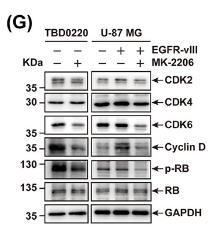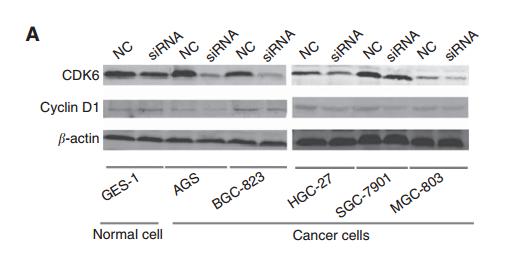产品描述
*The optimal dilutions should be determined by the end user.
*Tips:
WB: 适用于变性蛋白样本的免疫印迹检测. IHC: 适用于组织样本的石蜡(IHC-p)或冰冻(IHC-f)切片样本的免疫组化/荧光检测. IF/ICC: 适用于细胞样本的荧光检测. ELISA(peptide): 适用于抗原肽的ELISA检测.
引用格式: Affinity Biosciences Cat# AF0931, RRID:AB_2835325.
展开/折叠
AI327039;B cell CLL/lymphoma 1;B cell leukemia 1;B cell lymphoma 1 protein;B-cell lymphoma 1 protein;BCL 1;BCL-1;BCL-1 oncogene;BCL1;BCL1 oncogene;ccnd1;CCND1/FSTL3 fusion gene, included;CCND1/IGHG1 fusion gene, included;CCND1/IGLC1 fusion gene, included;CCND1/PTH fusion gene, included;CCND1_HUMAN;cD1;Cyl 1;D11S287E;G1/S specific cyclin D1;G1/S-specific cyclin-D1;Parathyroid adenomatosis 1;PRAD1;PRAD1 oncogene;U21B31;
抗原和靶标
- P24385 CCND1_HUMAN:
- Protein BLAST With
- NCBI/
- ExPASy/
- Uniprot
MEHQLLCCEVETIRRAYPDANLLNDRVLRAMLKAEETCAPSVSYFKCVQKEVLPSMRKIVATWMLEVCEEQKCEEEVFPLAMNYLDRFLSLEPVKKSRLQLLGATCMFVASKMKETIPLTAEKLCIYTDNSIRPEELLQMELLLVNKLKWNLAAMTPHDFIEHFLSKMPEAEENKQIIRKHAQTFVALCATDVKFISNPPSMVAAGSVVAAVQGLNLRSPNNFLSYYRLTRFLSRVIKCDPDCLRACQEQIEALLESSLRQAQQNMDPKAAEEEEEEEEEVDLACTPTDVRDVDI
种属预测
score>80的预测可信度较高,可尝试用于WB检测。*预测模型主要基于免疫原序列比对,结果仅作参考,不作为质保凭据。
High(score>80) Medium(80>score>50) Low(score<50) No confidence
翻译修饰 - P24385 作为底物
| Site | PTM Type | Enzyme | Source |
|---|---|---|---|
| K33 | Ubiquitination | Uniprot | |
| K46 | Methylation | Uniprot | |
| K46 | Ubiquitination | Uniprot | |
| K50 | Ubiquitination | Uniprot | |
| S90 | Phosphorylation | P17612 (PRKACA) | Uniprot |
| K95 | Ubiquitination | Uniprot | |
| K96 | Ubiquitination | Uniprot | |
| S111 | Phosphorylation | Uniprot | |
| K112 | Ubiquitination | Uniprot | |
| K114 | Ubiquitination | Uniprot | |
| S131 | Phosphorylation | Uniprot | |
| K167 | Ubiquitination | Uniprot | |
| K175 | Ubiquitination | Uniprot | |
| K180 | Ubiquitination | Uniprot | |
| S197 | Phosphorylation | P17612 (PRKACA) | Uniprot |
| S219 | Phosphorylation | Uniprot | |
| Y226 | Phosphorylation | Uniprot | |
| S234 | Phosphorylation | P17612 (PRKACA) | Uniprot |
| K238 | Ubiquitination | Uniprot | |
| K269 | Ubiquitination | Uniprot | |
| T286 | Phosphorylation | Q13627 (DYRK1A) , Q9Y463 (DYRK1B) , P49841 (GSK3B) , O15111 (CHUK) | Uniprot |
| T288 | Phosphorylation | P49841 (GSK3B) , Q9Y463 (DYRK1B) | Uniprot |
研究背景
Regulatory component of the cyclin D1-CDK4 (DC) complex that phosphorylates and inhibits members of the retinoblastoma (RB) protein family including RB1 and regulates the cell-cycle during G(1)/S transition. Phosphorylation of RB1 allows dissociation of the transcription factor E2F from the RB/E2F complex and the subsequent transcription of E2F target genes which are responsible for the progression through the G(1) phase. Hypophosphorylates RB1 in early G(1) phase. Cyclin D-CDK4 complexes are major integrators of various mitogenenic and antimitogenic signals. Also substrate for SMAD3, phosphorylating SMAD3 in a cell-cycle-dependent manner and repressing its transcriptional activity. Component of the ternary complex, cyclin D1/CDK4/CDKN1B, required for nuclear translocation and activity of the cyclin D-CDK4 complex. Exhibits transcriptional corepressor activity with INSM1 on the NEUROD1 and INS promoters in a cell cycle-independent manner.
Phosphorylation at Thr-286 by MAP kinases is required for ubiquitination and degradation following DNA damage. It probably plays an essential role for recognition by the FBXO31 component of SCF (SKP1-cullin-F-box) protein ligase complex.
Ubiquitinated, primarily as 'Lys-48'-linked polyubiquitination. Ubiquitinated by a SCF (SKP1-CUL1-F-box protein) ubiquitin-protein ligase complex containing FBXO4 and CRYAB. Following DNA damage it is ubiquitinated by some SCF (SKP1-cullin-F-box) protein ligase complex containing FBXO31. SCF-type ubiquitination is dependent on Thr-286 phosphorylation (By similarity). Ubiquitinated also by UHRF2 apparently in a phosphorylation-independent manner. Ubiquitination leads to its degradation and G1 arrest. Deubiquitinated by USP2; leading to its stabilization.
Nucleus. Cytoplasm. Nucleus membrane.
Note: Cyclin D-CDK4 complexes accumulate at the nuclear membrane and are then translocated to the nucleus through interaction with KIP/CIP family members.
Interacts with FBXO4 (By similarity). Interacts with either CDK4 or CDK6 protein kinase to form a serine/threonine kinase holoenzyme complex. The cyclin subunit imparts substrate specificity to the complex. Component of the ternary complex CCND1/CDK4/CDKN1B required for nuclear translocation and modulation of CDK4-mediated kinase activity. Interacts directly with CDKN1B. Interacts with UHRF2; the interaction ubiquitinates CCND1 and appears to occur independently of phosphorylation. Can form similar complexes with either CDKN1A or CDKN2A. Interacts with USP2. Interacts (via cyclin N-terminal domain) with INSM1 (via N-terminal region); the interaction competes with the binding of CCND1 to CDK4 during cell cycle progression and inhibits CDK4 activity. Interacts with CDK4; the interaction is prevented with the binding of CCND1 to INSM1 during cell cycle progression.
Belongs to the cyclin family. Cyclin D subfamily.
研究领域
· Cellular Processes > Cell growth and death > Cell cycle. (View pathway)
· Cellular Processes > Cell growth and death > p53 signaling pathway. (View pathway)
· Cellular Processes > Cell growth and death > Cellular senescence. (View pathway)
· Cellular Processes > Cellular community - eukaryotes > Focal adhesion. (View pathway)
· Cellular Processes > Cellular community - eukaryotes > Tight junction. (View pathway)
· Environmental Information Processing > Signal transduction > FoxO signaling pathway. (View pathway)
· Environmental Information Processing > Signal transduction > PI3K-Akt signaling pathway. (View pathway)
· Environmental Information Processing > Signal transduction > AMPK signaling pathway. (View pathway)
· Environmental Information Processing > Signal transduction > Wnt signaling pathway. (View pathway)
· Environmental Information Processing > Signal transduction > Hedgehog signaling pathway. (View pathway)
· Environmental Information Processing > Signal transduction > Apelin signaling pathway. (View pathway)
· Environmental Information Processing > Signal transduction > Hippo signaling pathway. (View pathway)
· Environmental Information Processing > Signal transduction > Jak-STAT signaling pathway. (View pathway)
· Human Diseases > Drug resistance: Antineoplastic > Endocrine resistance.
· Human Diseases > Infectious diseases: Viral > Hepatitis B.
· Human Diseases > Infectious diseases: Viral > Measles.
· Human Diseases > Infectious diseases: Viral > Human papillomavirus infection.
· Human Diseases > Infectious diseases: Viral > HTLV-I infection.
· Human Diseases > Cancers: Overview > Pathways in cancer. (View pathway)
· Human Diseases > Cancers: Overview > Viral carcinogenesis.
· Human Diseases > Cancers: Overview > Proteoglycans in cancer.
· Human Diseases > Cancers: Overview > MicroRNAs in cancer.
· Human Diseases > Cancers: Specific types > Colorectal cancer. (View pathway)
· Human Diseases > Cancers: Specific types > Pancreatic cancer. (View pathway)
· Human Diseases > Cancers: Specific types > Endometrial cancer. (View pathway)
· Human Diseases > Cancers: Specific types > Glioma. (View pathway)
· Human Diseases > Cancers: Specific types > Prostate cancer. (View pathway)
· Human Diseases > Cancers: Specific types > Thyroid cancer. (View pathway)
· Human Diseases > Cancers: Specific types > Melanoma. (View pathway)
· Human Diseases > Cancers: Specific types > Bladder cancer. (View pathway)
· Human Diseases > Cancers: Specific types > Chronic myeloid leukemia. (View pathway)
· Human Diseases > Cancers: Specific types > Acute myeloid leukemia. (View pathway)
· Human Diseases > Cancers: Specific types > Small cell lung cancer. (View pathway)
· Human Diseases > Cancers: Specific types > Non-small cell lung cancer. (View pathway)
· Human Diseases > Cancers: Specific types > Breast cancer. (View pathway)
· Human Diseases > Cancers: Specific types > Hepatocellular carcinoma. (View pathway)
· Human Diseases > Cancers: Specific types > Gastric cancer. (View pathway)
· Human Diseases > Cardiovascular diseases > Viral myocarditis.
· Organismal Systems > Endocrine system > Prolactin signaling pathway. (View pathway)
· Organismal Systems > Endocrine system > Thyroid hormone signaling pathway. (View pathway)
· Organismal Systems > Endocrine system > Oxytocin signaling pathway.
文献引用
Application: WB Species: Human Sample: TBD0220, U-87 MG, and U-87 MG-EGFR-vIII cells
Application: WB Species: Mouse Sample: tumor tissue
Application: IHC Species: Mouse Sample: tumor tissue
Application: WB Species: Human Sample: TBD0220 and U87MG cells
Application: WB Species: human Sample: T24 and EJ cells
Application: WB Species: human Sample: U251 glioma cells
Application: WB Species: human Sample:
限制条款
产品的规格、报价、验证数据请以官网为准,官网链接:www.affbiotech.com | www.affbiotech.cn(简体中文)| www.affbiotech.jp(日本語)产品的数据信息为Affinity所有,未经授权不得收集Affinity官网数据或资料用于商业用途,对抄袭产品数据的行为我们将保留诉诸法律的权利。
产品相关数据会因产品批次、产品检测情况随时调整,如您已订购该产品,请以订购时随货说明书为准,否则请以官网内容为准,官网内容有改动时恕不另行通知。
Affinity保证所销售产品均经过严格质量检测。如您购买的商品在规定时间内出现问题需要售后时,请您在Affinity官方渠道提交售后申请。产品仅供科学研究使用。不用于诊断和治疗。
产品未经授权不得转售。
Affinity Biosciences将不会对在使用我们的产品时可能发生的专利侵权或其他侵权行为负责。Affinity Biosciences, Affinity Biosciences标志和所有其他商标所有权归Affinity Biosciences LTD.







